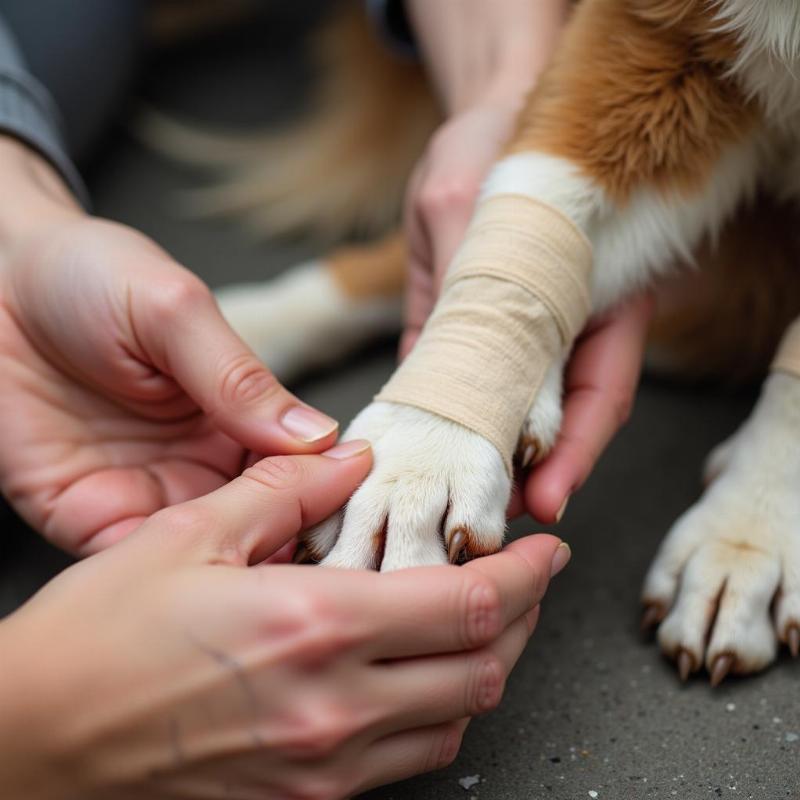Wound care for dogs requires specific products and a careful approach. Whether it’s a scrape, cut, bite, or surgical incision, understanding how to properly care for your dog’s wound is crucial for preventing infection and promoting healing. This guide explores various wound care for dogs products available in the US market, and provides practical advice on how to choose and use them effectively.
Understanding Different Types of Dog Wounds
Different types of wounds require different treatment approaches. A superficial scrape might only need cleaning and a topical ointment, while a deep laceration or bite wound may require veterinary intervention, including stitches and antibiotics. Knowing how to identify the wound type is the first step in selecting the appropriate wound care for dogs products.
- Abrasions (scrapes): These are superficial wounds affecting the outer skin layers.
- Lacerations (cuts): Deeper wounds that penetrate beyond the skin’s surface, potentially involving underlying tissues.
- Puncture wounds: Small but deep wounds caused by sharp objects. These are prone to infection and often require veterinary attention.
- Bite wounds: Caused by animal bites, these wounds are high-risk for infection due to bacteria from the biter’s mouth.
- Surgical incisions: Require specific care as directed by your veterinarian to ensure proper healing and minimize scarring.
Essential Wound Care for Dogs Products
Choosing the right wound care for dogs products can significantly impact your dog’s healing process. Here’s a breakdown of essential product categories:
Cleansers
Cleaning the wound is the first crucial step. Avoid using hydrogen peroxide or harsh soaps, as they can damage healthy tissue and impede healing. Opt for veterinary-approved antiseptic solutions like chlorhexidine or povidone-iodine diluted with sterile saline solution. These products effectively remove debris and bacteria without harming the wound. chlorhexidine oral rinse for dogs
Antiseptics
After cleaning, applying an antiseptic helps prevent infection. Antiseptic sprays, ointments, or wipes containing ingredients like chlorhexidine or benzalkonium chloride are readily available. bzk antiseptic towelette for dogs
Bandages and Dressings
Bandages and dressings protect the wound from further contamination and promote healing by providing a moist environment. Non-stick pads, gauze, and veterinary wraps are commonly used. Change the dressing regularly as instructed by your veterinarian.
 Applying Bandage to Dog Paw
Applying Bandage to Dog Paw
Topical Medications
Antibiotic ointments or creams can further help prevent infection and promote healing. Only use veterinary-prescribed antibiotic topicals, as some human antibiotics can be harmful to dogs. is mupirocin for dogs the same as humans
Pain Relief
Depending on the severity of the wound, your veterinarian might recommend pain medication to manage your dog’s discomfort. Never administer human pain relievers to your dog, as many are toxic. Always consult your veterinarian for safe and appropriate pain management options. lidocaine for dogs over the counter
When to Seek Veterinary Care
While minor scrapes can often be managed at home, deeper wounds, puncture wounds, bite wounds, and wounds showing signs of infection always require professional veterinary care. Signs of infection include redness, swelling, pus, increased pain, and lethargy.
Conclusion
Choosing the right wound care for dogs products is essential for effective healing and preventing complications. By understanding the different wound types and available treatment options, you can provide your furry friend with the best possible care. Remember, always consult your veterinarian for any wound that appears serious or shows signs of infection. Proper wound management, combined with veterinary guidance, ensures your dog’s quick recovery and return to optimal health.
FAQ
- What can I use to clean my dog’s wound at home? Diluted chlorhexidine or povidone-iodine solutions are safe and effective for cleaning dog wounds.
- Can I use Neosporin on my dog? While some formulations of Neosporin are safe for dogs, it’s best to consult your veterinarian before applying any human medication.
- How often should I change my dog’s bandage? Follow your veterinarian’s instructions regarding bandage changes, typically every 1-2 days.
- When should I take my dog to the vet for a wound? Deep wounds, puncture wounds, bite wounds, and wounds showing signs of infection require immediate veterinary attention.
- What are the signs of a infected wound in a dog? Redness, swelling, pus, increased pain, warmth around the wound, and lethargy can indicate infection.
Beautdogs.us is your premier resource for all things dog-related in the US. We provide expert advice on dog breeds, care, and products to help you navigate the joys and challenges of dog ownership. Whether you’re a new dog parent or a seasoned expert, Beautdogs.us is your trusted source for comprehensive and engaging information. Contact us today for any inquiries: Email: [email protected], Phone: +1 501-555-7529. Let Beautdogs.us help you keep your canine companion happy and healthy.